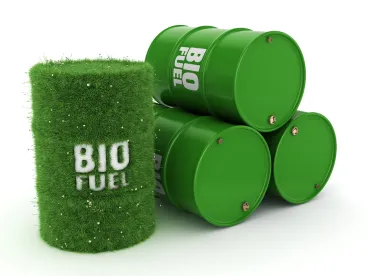Growing interest in Renewable Natural Gas plays has our team taking a closer look at the profitability and sustainability merits of making natural gas from animal manure, landfill gas, food waste, or wastewater.
What is it?
Renewable Natural Gas (RNG), or biogas, is natural gas that comes from decomposing and purifying organic matter. It can be used for a variety of purposes, including generating electricity and heating for power plants and as various types of fuels.
Is it money?
Likely. RNG projects are at an interesting intersection: a proliferation of government incentives, an uptick in recycling mandates and landfill bans, and a wide variety of financing options. For savvy RNG investors, this can translate into double-digit rates of return resulting from an increase in profit channels, fueled by growing demand and topped off with ease of financing.
Government Incentives
Several federal and state incentives are rewarding the use of renewable fuels. At the federal level, the Renewable Fuel Standard (RFS) program was enacted to reduce greenhouse gas emissions and reduce dependence on imported petroleum. It is implemented by the Environmental Protection Agency (EPA) in consultation with the U.S. Departments of Agriculture and Energy.
The RFS program requires a certain volume of renewable fuel (set by statute through 2022 for each of the four categories of renewable fuel: biomass-based diesel, cellulosic biofuel, advanced biofuel and total renewable fuel) to replace or reduce the quantity of refiners’ or importers’ petroleum-based transportation fuel, heating oil, or jet fuel. Each refiner or importer is required to comply with a specified renewable volume obligation (RVO), which can be met through the purchase of a credit called a renewable identification number (RIN).
Several states also have adopted similar programs, such as California’s Low Carbon Fuel Standard and Oregon’s Clean Fuels Program. These programs typically assign a carbon intensity (CI) value to each individual transportation fuel based on its fuel pathway (i.e., how it is made and delivered in the state for use in a vehicle). Sometimes a state will even recognize the CI value assigned by another state (e.g., Oregon accepts a fuel’s CI value approved by the California Air Resources Board, with modifications to reflect the fuel’s destination to Oregon). Other states, such as New York, New Jersey, Nevada, New Hampshire, Colorado and Washington, have included RNG as an option for complying with their respective regulatory mandates to increase production of energy from renewable resources, or are contemplating the adoption of RNG-related policies. Incentives can range from sales and use tax exemptions for RNG equipment, to RNG-infrastructure development through utility cost-recovery measures.
These incentives help alleviate the “Green Premium,” a term coined by Bill Gates to describe the additional costs associated with zero-carbon solutions (such as RNG) by comparison to their fossil-fuel counterparts (such as conventional natural gas).
Landfill Bans and Recycling Mandates
Several states, cities and counties have adopted food waste recycling laws – in each case with varying degrees of scope, compliance and alternate compliance, reporting and enforcement requirements. These laws are incentivizing, and in some cases, mandating, households and/or large institutions to recycle food waste. For example, New Jersey and New York recently passed mandates that will generally require certain businesses to send their food waste to recycling facilities instead of landfills. These businesses also may resort to composting, aerobic or anaerobic digestion (for RNG or biogas recovery), or other authorized alternative food waste recycling methods to comply with the applicable mandate.
Financing Options
In addition to grant and cost-share programs available for anaerobic digester operators, federal and state loan guarantees and tax-exempt private activity bonds can also help lower the cost of financing. More customary cost-sharing arrangements also may be available, such as where a utility or third party provides funding to an anaerobic digester project in exchange for a preferred return and/or the rights to the renewable energy credits or carbon offset credits.
Active Players
State agencies and commercial banks active in the space include the NY Green Bank, Rabobank, Live Oak Bank, and AgCredit. The space also is becoming attractive for global investment funds (such as EQT with its acquisition of Covanta, a Waste-to-Energy industry leader), as well as with development-stage capital funds (such as Leyline Renewable Capital with its strategic investments in waste-to-value streams including anaerobic projects). In addition, certain utilities are investing in projects to acquire RNG for their customers. For example, NW Natural, a publicly-traded utility headquartered in Oregon, is partnering with Tyson Foods and BioCarbN to invest in four separate RNG development projects that will convert methane to RNG, which will heat approximately 18,000 homes. NW Natural also is purchasing environmental attributes generated by a new RNG facility at a wastewater treatment plant in New York, and a Wisconsin-based mixed waste anaerobic digester facility as part of the RNG program instituted under Oregon Senate Bill 98.
SoCalGas, another utility based in Los Angeles, offers the opportunity for RNG to be accepted into its transmission and distribution system and delivered to its customers.
Gevo Inc., a publicly traded company, is using a combination of equity and tax-exempt private activity bonds issued by the Iowa Finance Authority to finance the construction of its facility in Northwest Iowa projected to generate approximately 355,000 MMBtu of RNG annually from the dairy manure of milking cows at nearby farms.
Multiple Revenue Streams
One distinctive feature of RNG projects is the ability to access multiple revenue streams, potentially including: (i) tipping fees received from large waste producers subject to landfill bans and recycling mandates, (ii) sales of RNG as transportation fuel (and even in some instances, sales of residual feedstock as fertilizer), and (iii) availability of federal and state renewable and low carbon fuel incentives. But a versatile investor may also combine other revenue-generating applications on any given project, such as fertilizer production and sales, and sales of biogas-generated power to the electric grid and associated renewable energy certificates (or at least offsetting a project’s electricity and heating costs); in many instances with the benefit of cross-pollination and without expanding the project’s real estate footprint.
Other more ambitious plays include the addition of carbon capture equipment and production of hydrogen. An array of federal tax credits are also available for qualifying RNG producers, retailers and wholesalers, businesses that utilize RNG as a transportation fuel, and power facilities that generate electricity using RNG.
Green or greenwashing?
Multiple shades of green. RNG is a viable alternative to conventional natural gas in cases of heavy-duty transportation and industrial processes. But it would replace only a modest percentage of today’s gas use.
From an environmental perspective, it seems RNG is more beneficial if it is made from manure rather than gas captured from landfills because landfills are typically capped and do not release their gas into the atmosphere (landfill gas typically is flared). The benefit of creating RNG from landfill gas is to limit the release of the carbon dioxide resulting from the flaring. Conversely, manure is often stored in open lagoons where both methane and carbon dioxide are released into the atmosphere. Capturing these emissions avoids releasing more potent gases into the atmosphere.
In addition, RNG plays can lend themselves to non-pipeline projects, positioning themselves as supply side solutions to serve local demand; thus bypassing the risk of leakage and build-out of new natural gas pipeline infrastructure.
Most RNG facilities, however, will still require an air permit, as their emissions (usually NOx) will typically exceed the permit minimum trigger threshold.
How do I get in on this?
Navigating the complex yet burgeoning RNG industry requires a deep understanding of governmental incentives and mandates (from determining eligibility to complying with reporting requirements, and avoiding penalties), and general project finance risk allocation expertise. For example, financing considerations may favor feedstock supply agreements with a fixed price structure, minimum delivery requirements, and liquidated damages protections. Feedstock purchasers may favor allocating project risk to feedstock suppliers (e.g., eligibility risk, production risk, and marketer discount) through realized net revenue percentage share structures, rather than agreeing to a compensation arrangement linked to animal count. Other considerations are important to the extent they inform contractual negotiation leverage: for example, understanding the actual cost of compliance with the requirements of any particular mandate and consequences of violations, together with the likelihood of enforcement, will set a natural cap and framework for negotiations with large food waste generators. Conversely, the introduction of incentives promoting compliance alternatives (such as composting and composting grant and guarantee programs) may also affect the outlook of a particular project.
On the revenue side, the value of RNG projects is highly dependent on regulatory changes. For example, the EPA may adjust the national RVOs on an annual basis, particularly after 2022 when the congressional guidelines fall away. The EPA may also waive such requirements if it determines that the RFS program is causing severe economic or environmental harm or if there is inadequate supply of biofuels to satisfy the mixture requirements. Further, small refiner exemptions may be available in some instances to exempt certain facilities from complying with the RFS program; exemptions and waivers may drive down the price of RINs.
Change in law risk may also be an event of termination in offtake agreements, thus jeopardizing the economic viability of the project. Registration, periodic reporting and other compliance obligations under the various government incentive programs (e.g., eligibility, annual CI score) may also jeopardize a project’s source of revenue if not carried out properly; this would be in addition to the more customary operational and other project risks. Feedstock selection will also be a key consideration: RNG projects from landfill gas capture have a relatively high CI (which is not as profitable but may be where demand is highest given the proliferation of landfill bans), while facilities that use manure as feedstock have the lowest CI because they prevent the release of methane into the atmosphere and may thus be more attractive.
While financing risk is potentially alleviated by the current availability of financing options, in many instances certain financing options are exclusionary of others (e.g., certain tax-exempt financings) and subject to limitations and compliance requirements as well.
Fortunately, investors with an expert understanding of the regulatory framework are well-positioned to mitigate certain risks. For example, RIN and LCFS generation may be preserved for biogas produced prior to the applicable regulatory approval, subject in some instances to physical storage arrangements. In addition, a thoughtful strategy with an eye on future potential combinations of revenue-generating streams (from onsite power generation to hydrogen production) will help map out and negotiate key mechanisms and protections in the underlying project documentation (e.g., feedstock exclusivity, non-competes, liquidated damages, incremental debt capacity and use of proceeds, change in law risk allocation).





 />i
/>i

